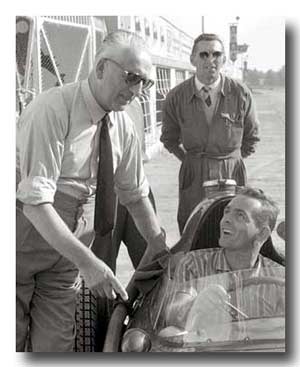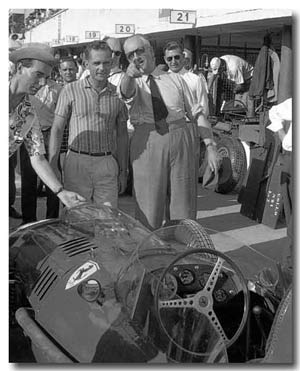I don’t know when Enzo Ferrari decided not to go to races in which his cars ran but to attend practice days instead, but such was his habit when I was covering the Grand Prix circuit. More often than not he was at Monza, sort of the home ball park, for the late summer Formula 1 races. And so as you see in this photograph shot at practice for the 1958 Grand Prix of Italy is “il Commendatore”, as he was usually referred to then, performing for my camera.
And I say “performing” purposely. Direct a camera in Ferrari’s direction and the ham in him rose like the sun. I have four or five shots of him that day as he was pointing his finger this way and that and, indeed, directly at me while keeping up a running commentary to Phil Hill. (I grouped several of the prints together and called them “Ferrari Makes a Point”.)
This day at Monza was of particular interest because it was Phil’s first Grand Prix race as a Ferrari F1 team driver. Yes, he was the team’s most successful competitor in sports car races like Sebring and Le Mans – races that earned points for what was then the only constructor’s championship. So he was valued, and yes, he had been promised a crack at Formula 1 since Luigi Chinetti “discovered” him in California. But he had been constantly put off with the team making one excuse after another.
If you enjoy this article by Denise McCluggage, please Donate or become a premium subscriber; only your support will keep these articles coming to your inbox every week!
Then in June of ’58 Phil won the 24 Hours of Le Mans (with Olivier Gendebien.) Wouldn’t this break the impasse? No. The Ferrari team persisted in their “we’ll-see” attitude when it came to promising him an F1 car for the Grand Prix of France two weeks after Le Mans.
At the urging of friends and colleagues, Phil accepted Jo Bonnier’s offer of a F1 Maserati which the Swedish driver owned and sometimes campaigned as a privateer. “They’ll pay good starting money for the Le Mans winner,” Jo told him. “Just don’t back out on me.” A group of us were having a post-race drink in the lobby of a Le Mans hotel. We all held our breath. Including Phil. Then he sighed and said yes. As was his wont, immediately regretted it. Nonetheless he went to Rheims to carry out his agreement with Jo and to add F1 to his racing resume.
Moods weren’t lightened much when in the Rheims paddock not long before the race was to start, Phil got one of those peculiar Italian hand waves that look like “go away” but mean “come here.” He was being summoned by Romolo Tavoni, Ferrari’s racing team manager. Speaking low and fast Tavoni told Phil that if he raced that Maserati he would never drive another Ferrari. Of any kind. Never.
But Phil had given Jo his word; he would indeed drive the Maser and it was one glum young man on the grid that day. Also driving his first — and only — Grand Prix at Rheims was Troy Ruttman, the American Indy 500 winner who had come to Europe for that strange War of Two Worlds confrontation between Indy-cars and European oddities at Monza and stayed on to do this…in a private Maserati.

Driving his last race in this unexpectedly dramatic Grand Prix was champion Juan Manuel Fangio in a Maserati team car. He then quit racing. I think I know the moment Fangio retired…in his mind at least. He announced nothing until the race was ended, but I saw the look on his face as he rolled into the pits during practice with a broken clutch. No, not a clutch that was not working but a truly broken clutch. He held the snapped-off pedal in his hand as he braked to a stop and wordlessly handed it to a mechanic. I think that was the moment. I think he said to himself: “I have five championships and a Mercedes dealership in Buenos Aires; I don’t need this.”
The race was the last for another driver: Luigi Musso. The only Italian on the Ferrari F1 team, Luigi was striving to keep up with his carefree English teammates – Peter Collins and Mike Hawthorn (who was to win that day) — and went off course going too fast on a moderately fast curve and died in a ditch with the car nested in tall grass.
Phil finished seventh in Jo’s weary Maserati and then contemplated a racing life dependent on Ferraris with nary a Ferrari in it.
However, as many of us suspected it might, Phil’s little rebellion had its effect. As did, of course, the loss of Musso from the Ferrari line-up. But instead of offering a retiring bobsledder or a new South American off-road champion a Grand Prix drive (“Pheel Heel” would wait; he would always wait) Ferrari had a car for him at Monza. And thus on this practice day I was photographing a bemused participant in Enzo Ferrari’s pointy performance.
At the end of 1961 — at this same circuit — Phil Hill would be crowned World Champion. In a Ferrari.
______________________________________________________________
An entertaining sidebar of this photograph is that guy in the cheap cowboy hat edging in at the left side of the print. That is none other than Bernard Cahier, known to those of us who also lugged cameras about, as “the most photographed photographer in motorsports”.
Just as an aimed lens moved Ferrari to start pointing at things Bernard was moved to put himself in front of that lens. He had been passing by, saw me shooting and decided the new Perspex hood over the carburetors demanded immediate investigation. In some prints of this I had someone more adept than I at such matters Photoshop Bernard out of the picture. But then I missed him. So here he is playing actor rather like Enzo Ferrari. Oscars all around.

A great article. Thanks for running it, Pete. Thanks for writing it, Denise.
Still have the letterfrom Phil Hill in Modena,,just few days after winning Le Mans,”so happy to finally see end of racein car”
mentioned Bonnier loanerfor Reims and thst Feerrari was disdpleased and would affect his future but iun his words phil said”,,Well i am going to do it anyway'(drive the Masersti andtakehis chances for future, suspsect thstevebn Denise typed his letter to mne from theAlbergo Reale Hotel, reading this agsin indicates JUST how unsure he wass about his future ast Ferrsri in 1958
jim sitz
Oregon
Denise has been mad at me for so long that I’ve forgotten why…but I still enjoy her delicious way with words describing an auto racing era that meant so much to both of us.
Rog Patterson
Like Dean Moriarty, Denise knows time.
I was a 10 year old stripling when I first read Denise McCluggage’s amazing and mesmerizing story of her first drive in the Lamborghini Miura in one of the old, short-lived American Sportsman quarterlys. (I still have a copy)
I have her to thank perhaps more than anyone else for this unfortunate obsession with Italian (and British) cars.
Thank you for so many years of what I can only call perfect writing Ms McCluggage. One of a kind.
Denise McCluggage is one of my favourite writers on motor racing. She was there, knew the people and writes superebly. By Brooks Too Broad for Leaping is one of the best motor racing books ever. More please! Ian Titchmarsh
I have been reading Denise for 35 years in Autoweek & Competition Press and I never get tired of listening. Her knowledge of the people , places and racing are unmatched in automotive journalism and her own racing career as one of the first women sports car racers adds even more interst to her stories.
Few tell a story as well as Denise. Whenever I tire of reading the current Stuff,” I find myself pulling Denise’s “By Brooks Too Broad for Leaping” and can turn to any page and be immediately drawn into the story and mesmerized by the tales of the way it was. For me, she occupies a place on the sharp end of the “writer, author, etc.” triangle. Thanks Denise for being you all these years!
Wonderful story from a legendary automotive writer. Denise, we all worship you. Thanks for joining Veloce Today and we hope to see more of your fine wit in future issues.
Denise or Jim Sitz,
In you wonderful collection of period pictures do you have any pictures of Henry Pickett – Europe 1957 or Jim any time or at any track or shop during the period.
I am a friend in Kuwait and would like to send something to Henry. Thank you
Perhaps in Tony Robinson’s new book. There should be one of Henry in Modena with Tony and Henry pushing I a 250F . Any thing you have I would be interested in to purchase.
JIM
to:
James Allen
yes Henry Pickett was dearfriend, bith in So Cal and Europe 1957. havephoto ofhe andPhil joking around with Monza motor…and henry “listening: to exhaust note of von Nemann 500 TR Pomona with Ken Miles amused
Jim Sitz
Lazydazy534@q.com